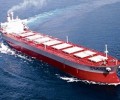
Capesize
A precipitous fall in the market this week had the Capesize 5TC shedding over 50 per cent in value. A small rebound at the end of the week gave slim hopes that the market may recover faster than anticipated. The Capesize 5TC lifted +402 to close the week out at $2394. Market troubles have been well brewed this year. With a concoction of interrupted cargo supplies, vessels racing on cheap bunkers, weather events, and demand destruction amid the Covid-19 pandemic, the market is in need of a positive. The iron ore stockpile situation in China has inventories dropping sharply, which will surely require tonnage. Half way through Q2 – and with many economies looking to re-open – there is talk of infrastructure spending to rekindle the flames, which will again require iron ore. While not an immediate relief, prospects are not all bleak. The West Australia to China C5 closed up +.314 to close the week at $3.942. While the Brazil to China C3 was heard to be better bid closing out the week up +.28 settling at $6.975.
Panamax
Rates in the Atlantic came under severe pressure this week. Sizeable losses on the respective routes, with absent mineral demand and long tonnage counts alleviated by ballaster numbers from the East in recent weeks, only compounded a bleak situation. Asia appeared to resist the negative sentiment emanating from other areas. There was a healthy volume of fresh enquiry and volume of fixtures, with the North Pacific seeing a steady flow of enquiry. However, minerals from Australia and Indonesia were the more dominant. End-week rates here were looking softer in most areas. EC south America saw healthy levels of fixing throughout the week but index-type tonnage by Thursday were only capable of achieving sub $11,500 + $150,000 numbers delivery at the port with a ballast bonus. NoPac rounds in the pacific hovered around the $6,000 for 82,000dwt, whilst the median rate for shorter Indonesian round trips lent towards the $5,000 mark.
Supramax/Ultramax
With a few areas in the world slowly getting back to a ‘new normal’, demand on the Ultramax/Supramax size increased. However, this split into two main camps with the Atlantic overall still soft, whilst from Asia and the Indian Ocean activity levels and rates increased. Little was reported on period activity. But a 56,000-dwt open Kandla was failed for five to eight months trading in the high $5,000s for the first 40 days – and $8,000 thereafter. From the Atlantic, east coast South America lacked enquiry with Supramax being fixed in the $4,000s for transatlantic runs. The east Mediterranean / Black Sea saw increased activity with cargo and tonnage being a little more balanced. All Asian routes gained ground during the week, a 55,000 open Iligan fixing at $6,500 via Indonesia redelivery India. The Indian Ocean had pent up demand, with a 63,000 fixing delivery South Africa for a trip to the Far East at $11,000 plus $150,000 ballast bonus.
Handysize
Midweek, the BHSI reached its lowest point of the year, with the same level last seen in early March 2016. The downward momentum in the Atlantic remained in all key areas. However, positive sentiment gained pace in the Pacific, with better rates discussed and more activity appearing in general. A mid/large Handy vessel was fixed from the north coast South America for a trip to the Far East at a rate close to mid $7,000s. A 37,000-dwt was fixed from Norfolk for a trip to the Continent/Baltic and a 33,000-dwt was fixed from Southwest Pass for a trip to east Mediterranean both at $2,500. In the East, more logs cargoes from New Zealand lent support and put vessels in Southeast Asia in demand. A 33,000-dwt open spot in CJK was fixed at $3,500 for a trip to Southeast Asia.
Source: The Baltic Briefing





